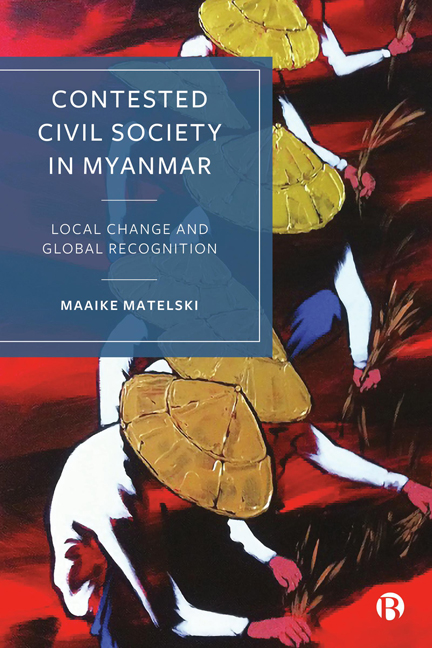Book contents
- Frontmatter
- Contents
- List of Abbreviations and Acronyms
- Acknowledgements
- Introduction: Contested Representation in Burma/Myanmar
- 1 Conflict, Repression and Resistance from Colonialism to Military Rule
- 2 Constructing Civil Society in Myanmar
- 3 Diversity and Fault Lines in Burmese Civil Society
- 4 Room to Manoeuvre under Authoritarian Rule
- 5 Transnational Advocacy Strategies and Pathways to Change
- 6 Competing Frames around the 2010 Elections
- 7 Foreign Aid and the (De)politicization of Civil Society Assistance
- 8 Interrupted Transition and Post-coup Resistance
- Conclusion
- Notes
- References
- Index
6 - Competing Frames around the 2010 Elections
Published online by Cambridge University Press: 28 March 2024
- Frontmatter
- Contents
- List of Abbreviations and Acronyms
- Acknowledgements
- Introduction: Contested Representation in Burma/Myanmar
- 1 Conflict, Repression and Resistance from Colonialism to Military Rule
- 2 Constructing Civil Society in Myanmar
- 3 Diversity and Fault Lines in Burmese Civil Society
- 4 Room to Manoeuvre under Authoritarian Rule
- 5 Transnational Advocacy Strategies and Pathways to Change
- 6 Competing Frames around the 2010 Elections
- 7 Foreign Aid and the (De)politicization of Civil Society Assistance
- 8 Interrupted Transition and Post-coup Resistance
- Conclusion
- Notes
- References
- Index
Summary
As part of the military’s ‘Roadmap to Democracy’, elections were scheduled for 2010. Once the date of 7 November was announced in August that year, a framing contest around the elections took off. Those who saw the elections as an opportunity made a strategic decision to emphasize the political and societal changes inside the country, while opponents chose to emphasize the lack of significant political change and the need to maintain pressure on the government. Both camps drew selectively on ‘marketing strategies’ to emphasize their points and steer developments in the desired direction. Moreover, both parties claimed to act for the larger good of the country in advancing their preferred strategies towards democratization. For foreigners, too, the ‘in-between’ position became ‘both more appealing and less tenable amid the polarization surrounding the 2010 elections’ (Metro, 2011: 10). Those who were optimistic about the increased space granted by the government were not alone in their expectation that the elections would bring about further change: research on Malaysia two years earlier, for example, shows that elections may offer unique opportunities for political engagement by civil society in repressive environments, and may lead to a re-assessment of relationships between politicians, the state and the people (Lee et al, 2010). For many people in Myanmar, the 2010 elections would be the first time they could vote at all, thus providing an opportunity to discuss politics more openly in the context of voter education (Lidauer, 2012).
Yet the 2010 elections and the surrounding controversies also provided a unique opportunity for those opposing the military government to campaign against its political framework. In the course of 2010, a large election boycott campaign emerged consisting of two elements: a domestic component, calling on people inside the country not to vote (though there was some confusion as to the actual goal of the campaign, as discussed subsequently), and an international component, calling on other governments not to acknowledge the election results as legitimate. Although an election boycott by opposition parties is not uncommon in politically restrictive environments (Kagwanja, 2005; Beaulieu, 2006), the campaign in Myanmar was additionally characterized by a high level of involvement by civil society organizations (CSOs) that took the opportunity to publicize their goals.
- Type
- Chapter
- Information
- Contested Civil Society in MyanmarLocal Change and Global Recognition, pp. 103 - 116Publisher: Bristol University PressPrint publication year: 2023



